| View previous topic :: View next topic |
| Author |
Message |
Rick_Albig
Key Member

Joined: 13 May 2006
Posts: 388
Location: Manchester
|
 Posted: Tue Mar 11, 2008 3:14 am Post subject: Heating large enclosure - How too guide Posted: Tue Mar 11, 2008 3:14 am Post subject: Heating large enclosure - How too guide |
 |
|
"How do you heat your large enclosures?"
I have been asked this question many times, in threads, PM's and in e-mails. This post will hopefully give you some ideas and help those of you who are struggling to maintain adequate temperatures in large enclosures. The following is how I do it and by no means the only way or the right way for every species. I currently heat two large enclosures in this way. The ones pictured are of a 12'x8'x5' enclosure used to house my pair of V.albigularis.
The first area I concentrate on is the basking site. This is the primary heat source for the whole enclosure. I use a bank of 6 60w R80 spot lights in this case (i remove two of the lights in the summer months as they are not required to achieve the required temps.) The fittings are mounted on a ply wood board and suspended by chain. This allows me to adjust the height of basking light until I have the desired surface temperature.
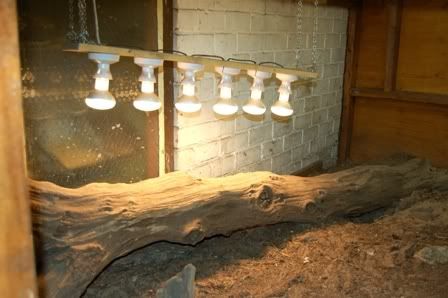
It is very important to make sure that the basking area is of even temperature gradient and it must cover at least the snout to vent length of your animal. This will prevent the risk of thermal burns from a reptile only being able to heat part of its body.
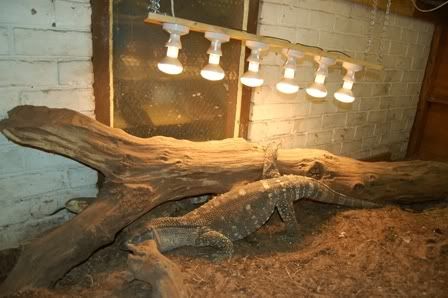
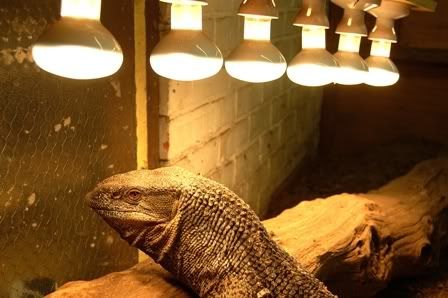
The temperature is checked using an infra red temperature gun. These are vital tool for any reptile enthusiast and can be purchased off ebay for about £15-20.
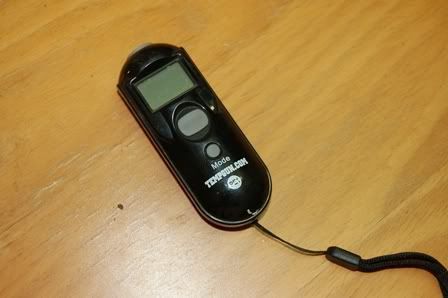

For my albigularis I have a SURFACE temp at around the 140f (60c) mark. This will vary from species to species but is a good guide for most varanids.
This bank of light heats the entire enclosure for 12 hours a day. I achieve a thermal gradient from about 90-68f (32-20c) with this set up and they use every bit of it!
At night when the lights go out I have a secondary heat source in the form of two CHE's (Ceramic Heat Emitters) These are both 150w.
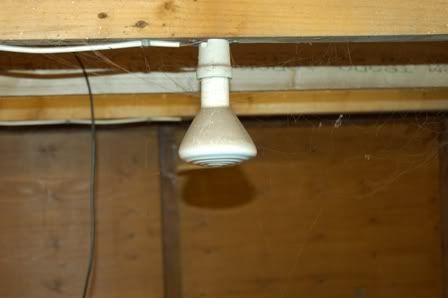
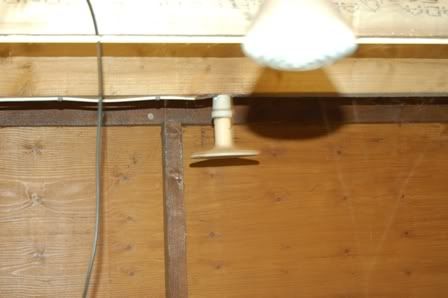
These are controlled by a pulse proportional thermostat that I have set on the lowest temperature I want the enclosure to be, in this case 68f (20c.) I find that it is only on the coldest winter nights that these CHE's are actually ever on (as you can tell by the cobwebs on them!) This is due to the fact that the enclosure is fairly well insulated and hold the heat from the day very well.
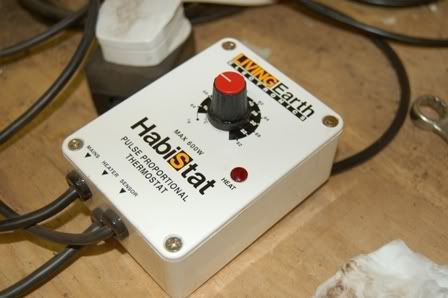

I have tried a few thermostats and found the habistat ones to be the best. These can also be custom ordered with any length of probe you want which is really useful! (mine are 3m long ones so I can position the probes in the middle of the enclosure)
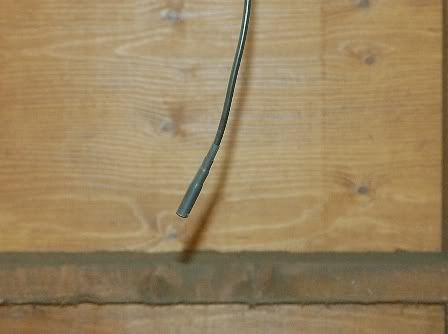
Well hope this all helps!
Rick |
|
| Back to top |
|
 |
Jas
Captivebred Communist

Joined: 17 Feb 2005
Posts: 1316
Location: Essex
|
 Posted: Tue Mar 11, 2008 6:48 pm Post subject: Posted: Tue Mar 11, 2008 6:48 pm Post subject: |
 |
|
Good informative post 
You could wire the two end spots through a dimmer stat and then you wouldnt have to remove them in the summer or when we have those rare warm spring days. 
_________________
www.Reptilebreeder.co.uk
Gutload Pro-Formula! |
|
| Back to top |
|
 |
Rick_Albig
Key Member

Joined: 13 May 2006
Posts: 388
Location: Manchester
|
 Posted: Tue Mar 11, 2008 10:59 pm Post subject: Posted: Tue Mar 11, 2008 10:59 pm Post subject: |
 |
|
Cheers everyone!
There is a very important point that I have completely overlooked in this post. I am a qualified electrical engineer and so have the knowledge and ability to do all of my own wiring and installation work. I do not recommend that you try this yourself unless you are 100% sure you know what you are doing! Iím sure I donít need to go into the danger of electricity but please for the safety of yourself and your reptiles always be sure of what you are doing or even better get some one who is qualified to do it for you!
Rick |
|
| Back to top |
|
 |
Rick_Albig
Key Member

Joined: 13 May 2006
Posts: 388
Location: Manchester
|
 Posted: Tue Mar 11, 2008 11:01 pm Post subject: Posted: Tue Mar 11, 2008 11:01 pm Post subject: |
 |
|
| Jas wrote: | You could wire the two end spots through a dimmer stat and then you wouldnt have to remove them in the summer or when we have those rare warm spring days.  |
Haha, ye i supose i could but they are all already wired upto an on/off stat just in case it gets too hot  |
|
| Back to top |
|
 |
crocdoc
Key Member
Joined: 07 Dec 2005
Posts: 262
Location: Sydney Australia - best address on Earth :)
|
 Posted: Wed Mar 12, 2008 12:38 am Post subject: Posted: Wed Mar 12, 2008 12:38 am Post subject: |
 |
|
| good post, Rick! |
|
| Back to top |
|
 |
Rick_Albig
Key Member

Joined: 13 May 2006
Posts: 388
Location: Manchester
|
 Posted: Sat Mar 15, 2008 4:35 pm Post subject: Posted: Sat Mar 15, 2008 4:35 pm Post subject: |
 |
|
Cheers crocdoc  |
|
| Back to top |
|
 |
|
















